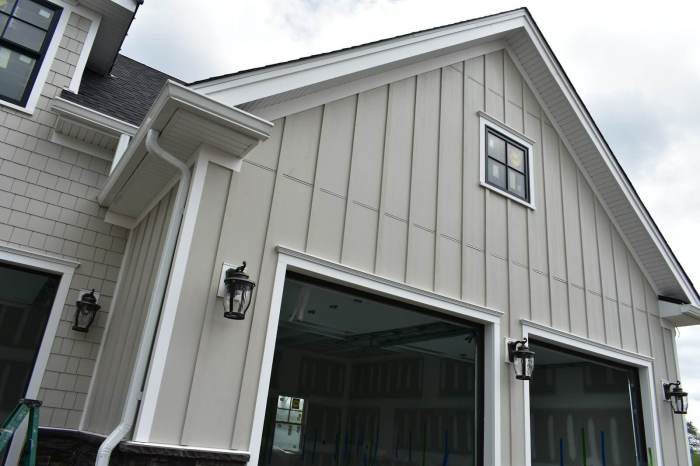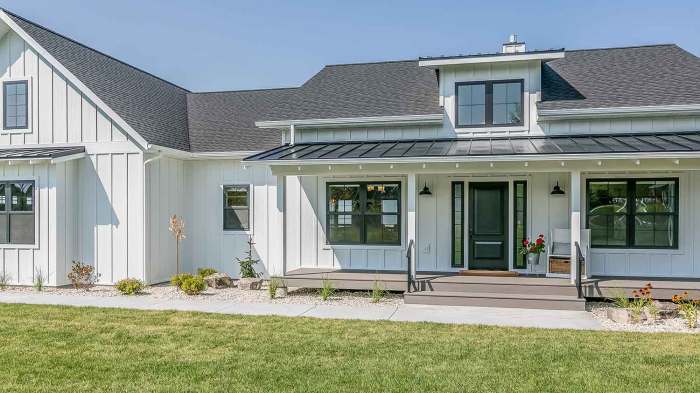As we delve into the world of home exteriors, the charm of board and batten design emerges as a focal point of interest. This unique siding style has a rich history and a timeless appeal that can transform any house into a picturesque dwelling.
Let's explore the intricacies of board and batten home exteriors, from installation processes to design inspirations, unlocking the secrets to creating a stunning facade that stands out in any neighborhood.
Definition of Board and Batten Home Exterior
Board and batten siding is a type of exterior cladding where wide boards are vertically installed with narrow strips known as battens covering the seams between the boards. This style creates a distinctive look that adds character and charm to a home's exterior.
Traditional Use of Board and Batten in Home Exteriors
Historically, board and batten siding was commonly used in early American architecture, particularly on barns, cabins, and cottages. The vertical lines created by the boards and battens provided structural support and protection from the elements, making it a practical choice for rural buildings.
Enhancing Visual Appeal of a Home
- Board and batten siding offers a timeless and classic aesthetic that can complement various architectural styles, from farmhouse to modern.
- The vertical lines of the boards and battens can visually elongate the appearance of a home, making it appear taller and grander.
- The contrasting textures of the wide boards and narrow battens create depth and interest, adding dimension to the facade of a home.
- Board and batten siding can be painted in a wide range of colors, allowing homeowners to customize the look of their home and make a bold design statement.
Installation Process for Board and Batten Siding

When it comes to installing board and batten siding, there are several key steps to follow to ensure a successful and durable outcome. Paying attention to details and avoiding common mistakes can make a significant difference in the final result.
Preparation
Before starting the installation process, make sure to properly prepare the surface where the siding will be installed. This includes cleaning the area, removing any old siding or debris, and ensuring that the surface is smooth and even.
- Measure and cut the boards to the desired length before installation.
- Prime and paint the boards before installing to ensure complete coverage.
- Mark the studs on the wall to guide the placement of the boards.
Installation
Once the preparation is complete, it's time to start installing the board and batten siding.
- Start by installing the boards horizontally, ensuring they are level and properly spaced.
- Secure the boards to the wall using nails or screws, making sure to hit the studs for proper support.
- Once the boards are in place, install the vertical battens over the seams between the boards to create the classic board and batten look.
Finishing Touches
To ensure a seamless and durable installation, pay attention to the finishing touches.
- Fill any nail holes with wood putty and sand them down for a smooth finish.
- Apply a final coat of paint to the entire surface to protect the siding from the elements.
- Regularly inspect the siding for any signs of damage or wear and make repairs as needed to maintain its integrity.
Remember, attention to detail and proper preparation are key to a successful board and batten siding installation.
Materials Used for Board and Batten Siding

When it comes to board and batten siding, there are several materials that can be used to achieve the desired look
Wood
- Pros:
- Natural and traditional look
- Can be easily painted or stained
- Durable and long-lasting if properly maintained
- Cons:
- Prone to rot, warping, and insect damage if not maintained
- Requires regular maintenance such as painting or staining
- Higher initial cost compared to other materials
Vinyl
- Pros:
- Low maintenance and easy to clean
- Wide range of colors and styles available
- Cost-effective option
- Cons:
- Less traditional look compared to wood
- Not as environmentally friendly as other materials
- Potential for fading or cracking over time
Fiber Cement
- Pros:
- Durable and resistant to rot, fire, and insects
- Low maintenance and long-lasting
- Can mimic the look of wood without the maintenance
- Cons:
- Higher initial cost compared to vinyl
- Requires professional installation
- Heavier material that may require additional support
Recommendations
When selecting the most suitable material for a specific home exterior, consider factors such as budget, maintenance requirements, desired aesthetic, and climate conditions. Wood is a great option for a traditional look but requires more upkeep, while vinyl is low maintenance but may not offer the same level of authenticity.
Fiber cement strikes a balance between durability and aesthetics but comes at a higher cost. Ultimately, choose the material that best fits your needs and priorities for your board and batten siding.
Design Ideas and Variations for Board and Batten Homes
When it comes to designing board and batten homes, there are various options to explore that can greatly impact the overall look of the exterior. The choice of color, as well as the creative ways in which board and batten siding is used, can help achieve different architectural styles.
Color Choices Impact
Color plays a significant role in the overall appearance of a board and batten home exterior. Lighter colors can create a more airy and traditional feel, while darker colors can add a modern and bold touch. Neutral tones like white, cream, or gray are popular choices that can provide a timeless and classic look.
Creative Use of Board and Batten Siding
Board and batten siding can be used in creative ways to achieve various architectural styles. For a farmhouse or rustic look, consider combining board and batten with stone accents. To achieve a more modern aesthetic, mix materials like metal or concrete with board and batten siding.
Additionally, playing with the width of the boards or incorporating different patterns can add visual interest and uniqueness to the design.
Closing Summary
In conclusion, board and batten siding offers a versatile and eye-catching option for elevating the look of your home exterior. By combining traditional elements with modern aesthetics, this design choice can truly make a statement and enhance the overall curb appeal of your property.
Discover the endless possibilities that board and batten brings to your doorstep, and embark on a journey of architectural creativity and visual delight.
Essential Questionnaire
What are the benefits of board and batten siding?
Board and batten siding offers excellent durability, easy maintenance, and a unique visual appeal that can enhance the character of any home.
Can board and batten siding be painted?
Yes, board and batten siding can be painted in a variety of colors to suit your design preferences and complement your home's aesthetic.
Is board and batten siding suitable for all types of architectural styles?
While traditionally used in farmhouse and cottage-style homes, board and batten siding can be adapted to various architectural designs, adding a touch of charm and elegance.







